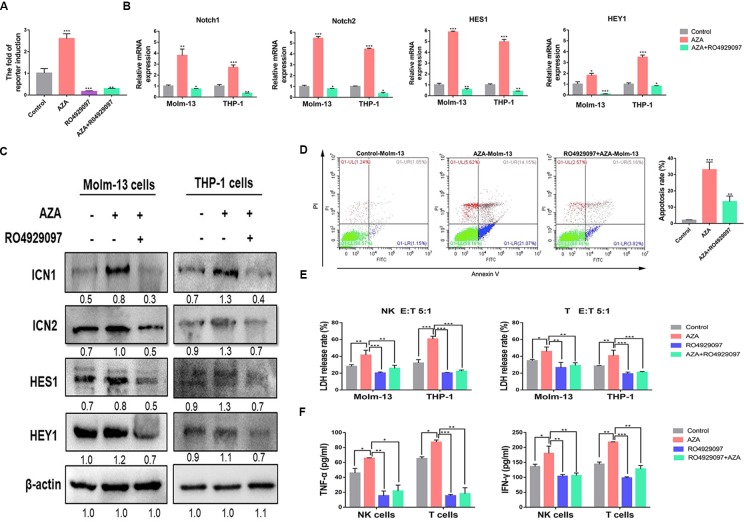Figure 6.
Azelaic acid (AZA) exerts anti-leukemic effect by activating the Notch signaling pathway. (A) Notch responsive elements were transfected into 293T cells after 24 h. Cells were then treated with 10 µM AZA, 10 µM RO4929097, and combination for 24 h, the Notch signaling reporter assay was measured by dual luciferase reporter activity. (B) Validation of the RNA expression of Notch1 and Notch2, the downstream target genes HES1 and HEY1 in Molm-13 and THP-1 cells by qPCR. (C) The protein expression level of ICN1, ICN2, HEY1, and HES1 in acute myeloid leukemia (AML) cell lines after treatment of AZA and RO4929097 and their detection by western blot. ImageJ was used for the densitometric analysis. Data represent means ± SD. (D) Molm-13 cells were pretreated with 10 µM RO4939097 for 24 h, and then treated with 10 µM AZA for another 24 h. Cells were collected for apoptosis analysis. (E) NK cells and T cells were pretreated with 10 µM AZA, 10 µM RO4929097, and combination for 24h before co-culture with THP-1 cell and Molm-13 cells at an E:T ratio of 5:1. The cytotoxicity of NK and T was determined by detecting the LDH release rate. (F) NK and T cells were pre-treated with AZA and RO4929097, then co-cultured with THP-1 cell at an E:T ratio of 3:1 for 4 h. The level of TNF-α and IFN-γ in the supernatant was measured by ELISA. A Total of three independent experiments were performed. *P < 0.05, **P < 0.01,***P < 0.001.

